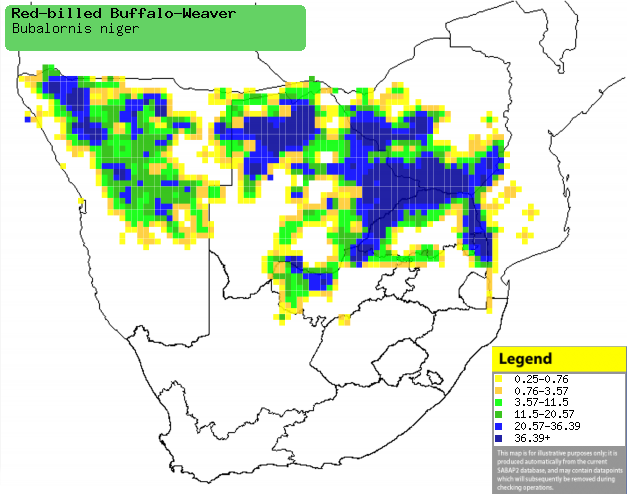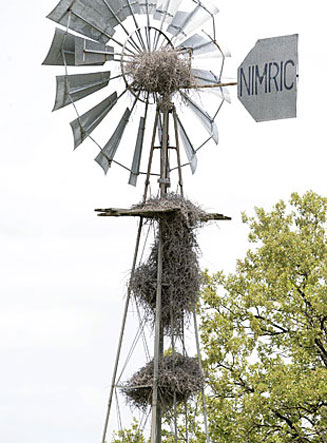|
Bubalornis niger (Red-billed
Buffalo Weaver)
Buffelwewer [Afrikaans]; Kamugcara (check: same name as
African pygmy-goose) [Kwangali]; Xighonyombha [Tsonga]; Mabônyana,
Pônyane [Tswana]; Roodsnavel-buffelwever [Dutch]; Alecto à bec rouge
[French]; Büffelweber [German]; Tecelão-de-bico-vermelho [Portuguese]
Life
> Eukaryotes >
Opisthokonta
> Metazoa (animals) >
Bilateria >
Deuterostomia >
Chordata >
Craniata > Vertebrata (vertebrates) > Gnathostomata (jawed
vertebrates) > Teleostomi (teleost fish) > Osteichthyes (bony fish) > Class:
Sarcopterygii (lobe-finned
fish) > Stegocephalia (terrestrial
vertebrates) >
Tetrapoda
(four-legged vertebrates) > Reptiliomorpha > Amniota >
Reptilia (reptiles) >
Romeriida > Diapsida > Archosauromorpha > Archosauria >
Dinosauria
(dinosaurs) > Saurischia > Theropoda (bipedal predatory dinosaurs) >
Coelurosauria > Maniraptora > Aves
(birds) > Order: Passeriformes
> Family: Ploceidae
Distribution and habitat
Occurs in two separate areas of sub-Saharan Africa; one
extending from Somalia and Ethiopia through to Tanzania and the other population
from southern DRC, Angola and Zambia to southern Africa. Here it is locally
common from northern and central Namibia to Botswana, Zimbabwe, southern
Mozambique and northern and north-eastern South Africa, generally preferring
Acacia savanna, especially when it has been disturbed by humans and
livestock
|
 |
|
Distribution of Red-billed weaver in southern
Africa, based on statistical smoothing of the records from first SA Bird
Atlas Project (©
Animal Demography unit, University of
Cape Town; smoothing by Birgit Erni and Francesca Little). Colours range
from dark blue (most common) through to yellow (least common).
See here for the latest distribution
from the SABAP2. |
Predators and parasites
The nestlings and sometimes adults are thought
to be hunted by the following animals:
Food
It eats insects, seeds and fruit, doing most of its
foraging on the ground, searching the soil and low vegetation for food. The following food items have been recorded
in its diet:
Breeding
- It is breeds in colonies (see image below for an example) made up of
different separate "lodges", each with a number of nesting chambers within
them. The males may be polygamous, each controlling 1-8 nest chambers and up
to about 3 females; usually there is one dominant male in a colony who has
the most females and egg chambers, while other males may have one female and
a few chambers. The males vigorously defend their lodges against other
males, using aggressive displays and calls, and females within harem do not
tolerate each others presence in their egg chambers. Colonies may use a
different system altogether, with two males cooperating with each other to
build the nest, both defending the territory and helping to feed the chicks.
- The nest is a huge, bulky mass of interconnected thorny twigs, divided
into separate complexes (lodges) with multiple egg chambers, each with a
nest built by the female, consisting of a ball of grass, leaves and roots.
The colony is typically placed in the branches of a large, often thorny tree
or alternatively a windmill or pylon, usually near human habitation. In fact
if the people in the area leave, the colony often departs as well. Large
raptors such as White-backed vultures (Gyps
africanus) and Bateleurs (Terathopius ecaudatus)
often build their nests on top of Red-billed buffalo-weaver nests; this is
though to be mutually beneficial, as the raptor nests are camouflaged
and the weavers are protected from other predators.
 |
|
|
Red-billed buffalo-weaver colony in a
windmill, Phabeni Gate area, Kruger Park, South Africa.
[photo
Warwick Tarboton ©] |
|
- Egg-laying season is from September-June, peaking from about
December-March
- It lays 2-4 eggs, which are incubated solely by the female for about 14
days.
- The chicks are usually fed solely by the female (except in cooperative
breeding colonies, see above) on a diet of insects collected in and around
the nest, leaving after about 20-23 days.
Threats
Not threatened, in fact it has benefited from the
destruction, disturbance and settlement by humans in savanna.
References
-
Hockey PAR, Dean WRJ and Ryan PG 2005. Roberts
- Birds of southern Africa, VIIth ed. The Trustees of the John Voelcker
Bird Book Fund, Cape Town.
|
